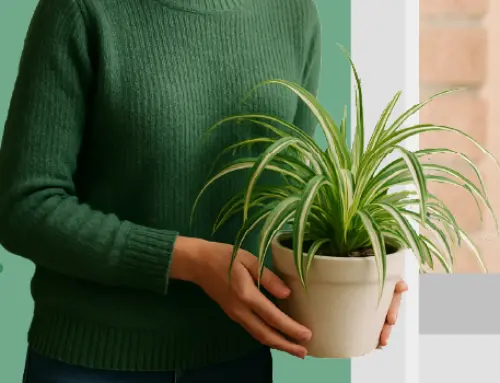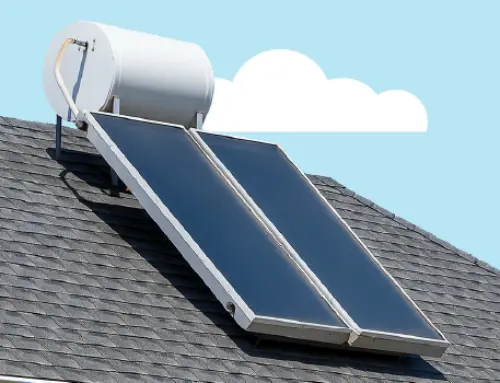What Planting Zone is Ohio?
by Jenna Mendez
19.6 min read
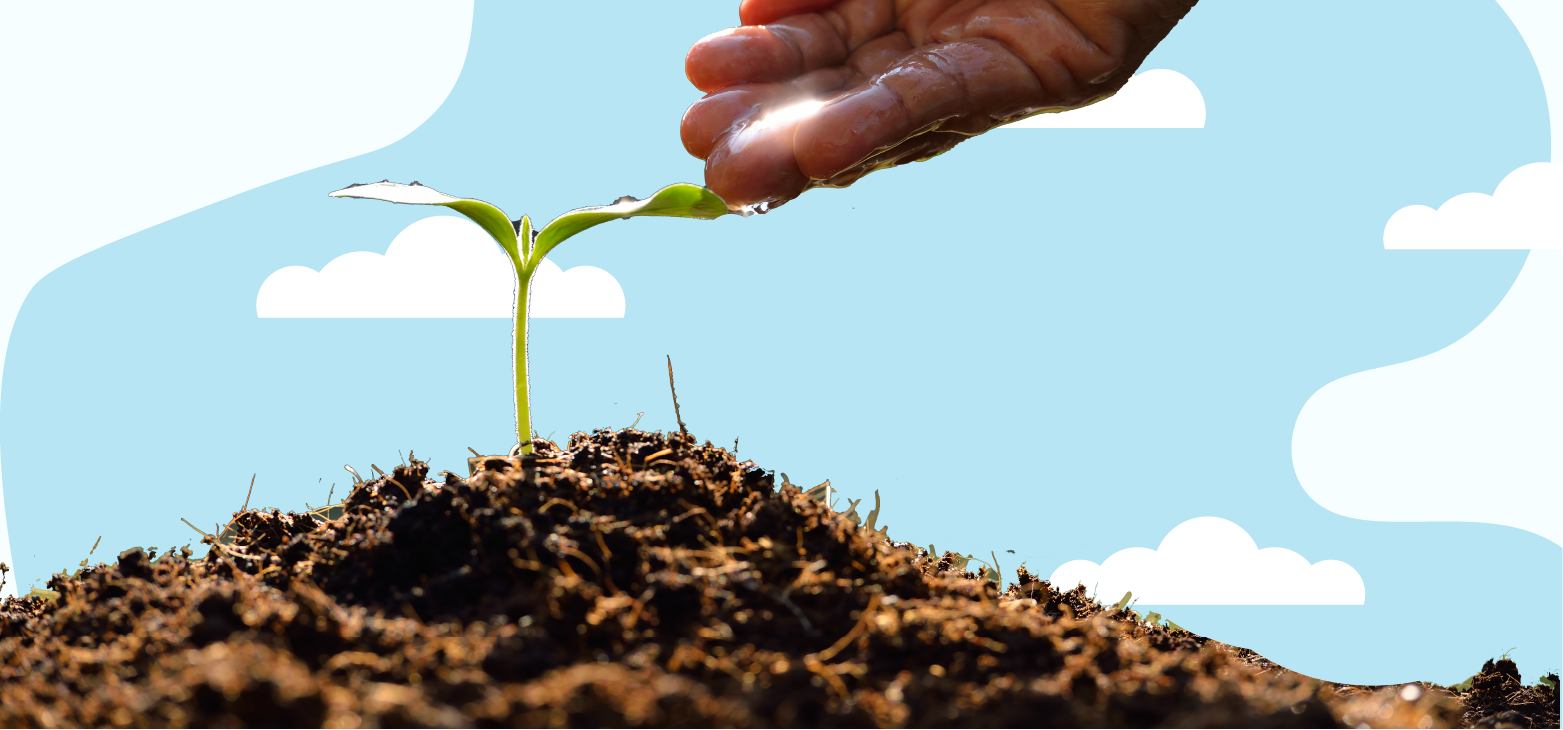
One of the most important factors for gardening success is understanding your planting zone. The USDA Plant Hardiness Zone Map is a critical tool that helps gardeners determine which plants are best suited for their region.
This map divides the United States into zones based on average minimum winter temperatures, providing a reliable guide for plant selection and care. So, which planting zone is Ohio in? Whether you're a seasoned gardener or just getting started, this guide will help you create a vibrant and thriving garden in the Buckeye State.
What is a Planting Zone, and Why Does it Matter?
A planting zone, also known as a hardiness zone, is a classification system created by the USDA to divide regions of the country based on historical weather patterns. The USDA Plant Hardiness Zone Map serves as a key reference for gardeners and growers to identify the perennial plants best suited for a specific location, such as in Ohio.
This map guides gardeners by identifying the lowest temperatures plants can withstand to survive and thrive. Not all plants are suited for every climate, and this information prevents unnecessary plant loss due to extreme weather.
Each plant is assigned a specific hardiness zone, indicating its ability to withstand the lowest temperatures in that region. Usually, when you visit your local garden center, the hardiness zones a plant can withstand are printed on the plastic pot of the plant or on its tag to ensure you’re choosing the right plant for your zone.
Planting a species outside its designated zone may expose it to extreme heat or cold, potentially causing stress or damage. By understanding these zones, you can choose and care for the best trees, shrubs, and perennials for your landscape, ensuring long-term success.
What Planting Zone Is Ohio?
Ohio’s planting zones are 5b, 6a, 6b, and 7a. Ohio’s placement within these zones is influenced by various geographical factors, such as its proximity to Lake Erie, which moderates temperatures in the northern parts of the state, and its southern border, which benefits from slightly warmer conditions.
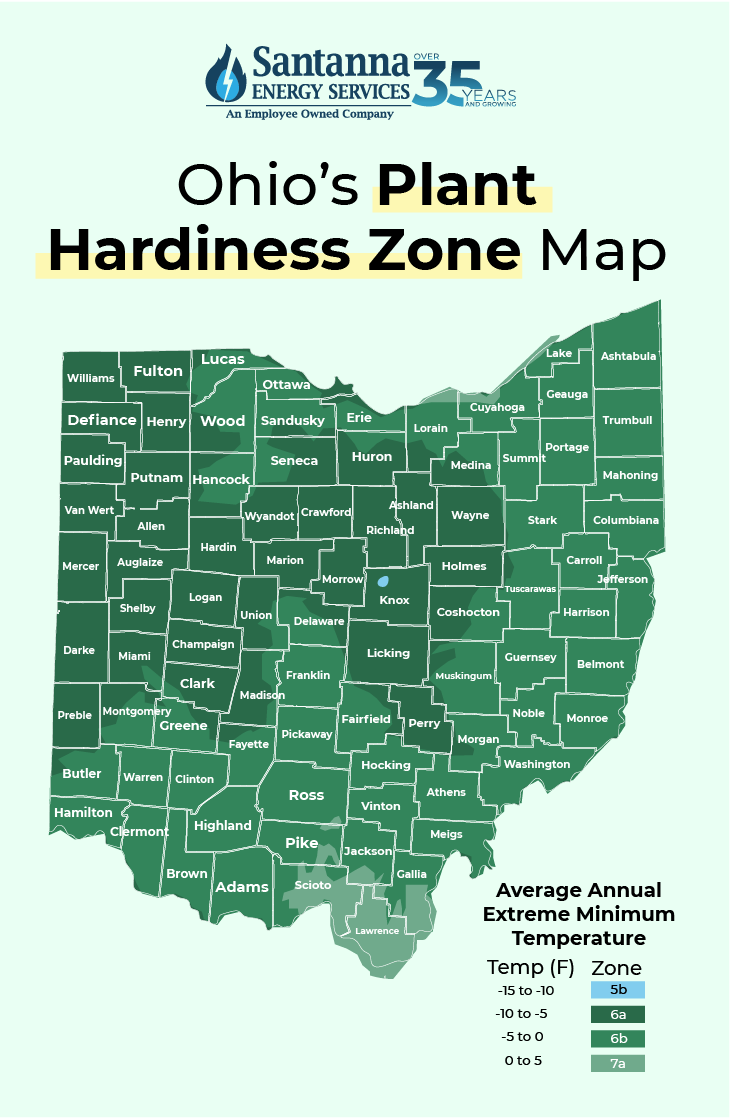
Zone 5b
Zone 5b covers a tiny portion of Ohio. Towns in Ohio planting Zone 5b include Mount Vernon and small portions of Apple Valley Lake in Knox County. This zone experiences average minimum winter temperatures between -15°F and -10°F. A possible reason for Zone 5b being so small is local microclimate factors like higher elevation, increased wind exposure, or proximity to bodies of water that create slightly colder conditions.
Cold winters mean plants must be hardy enough to survive freezing temperatures and occasional frost. Plants that thrive the most in these conditions include perennials like Phlox, Black-Eyed Susans, and Daylilies, trees like Maples and Oaks, and vegetables like carrots and spinach.
Avoid planting heat-sensitive plants, like citrus trees or tropical varieties that cannot tolerate extended freezing conditions within this zone.
Zone 6a
Zone 6a is found across much of central Ohio, including portions of the northeast and northwest regions. Portions of Medina, Portage, Carroll, and Wood counties are in Ohio planting Zone 6a. Meanwhile, counties like Mahoning, Holmes, Marion, and Clark are fully engrossed in Ohio planting Zone 6a. The average minimum winter temperatures range from -10°F to -5°F. This zone experiences slightly milder winters than Zone 5b, offering a longer growing season.
Perennials like Lavender and Coreopsis and flowering shrubs like Hydrangeas thrive in this zone. Vegetables such as tomatoes, peppers, and cucumbers also flourish in this zone.
Avoid planting extremely cold-reliant plants that require prolonged freezing periods, as winters in this zone may not stay cold enough for dormancy. Like Zone 5b, avoid planting tropical plants or citrus trees as they can’t survive in Zone 6a’s low and freezing temperatures.
Zone 6b
Zone 6b includes most of southern Ohio and stretches west of Toledo to the Pennsylvania border in northern Ohio. With average minimum winter temperatures between -5°F and 0°F, this zone has one of the mildest climates in Ohio. The extended growing season supports a wide variety of plants.
Portions of Franklin, Erie, Lucas, Summit, and Stark counties are in Ohio planting Zone 6b. Counties like Meigs, Monroe, Clinton, and Hamilton sit fully within Zone 6b.
Heat-tolerant plants like Butterfly Bushes and Roses perform well in this zone. Vegetables like squash and eggplants can survive these temperatures because they are hardy and thick outside. Additionally, trees like Dogwoods and Japanese Maples perform well because they are adaptable to the region’s moderate winters and can thrive in well-drained soil with partial to full sun exposure.
Although winter is bearable in this zone for most plants to survive through the winter, avoid planting plants that require prolonged cold or extreme winter conditions, such as Arctic Willows or high-elevation alpine species. When the temperature rises in this zone, these plants may struggle to thrive, as they require consistently cold conditions to maintain dormancy.
Zone 7a
Zone 7a is found in a narrow area near Greater Cleveland, just inland from Lake Erie and at the southernmost tip of Ohio. Average minimum winter temperatures range from 0°F to 5°F. This unique zone benefits from the moderating effect of Lake Erie and slightly warmer conditions at the southern tip of the state.
Portions of Cuyahoga, Lake, Lorrain, Scioto, Jackson, and Pike counties are in Ohio planting Zone 7a. Lawrence County is fully within Zone 7a.
Heat-loving plants like ornamental grasses, Crepe Myrtle, and flowering perennials like Coreopsis and Black-Eyed Susans flourish in these warmer climates. Avoid planting cold-reliant species that require deep freezes, as this zone rarely experiences prolonged freezing temperatures.
What Planting Zone is Cincinnati, Ohio in?
Cincinnati’s planting zone, Zone 6b, enjoys milder winters and a longer growing season than northern Ohio. This climate allows gardeners to grow a diverse range of plants, from perennials like Daylilies and Coneflowers to vegetables such as tomatoes and peppers.
However, plants that struggle in mild winters, such as alpine plants or those requiring a dormancy period with freezing temperatures, may not thrive here. Additionally, Cincinnati’s location in Southwest Ohio often benefits from slightly warmer microclimates, particularly in urban areas where buildings retain heat.
What Planting Zone is Cleveland, Ohio in?
Cleveland’s planting zone is mostly Zone 6a, with some parts falling into Zone 7a, as its climate is heavily influenced by nearby Lake Erie. The lake’s moderating effect prevents extreme winter temperatures, but it also contributes to heavy snowfall and frost, creating challenges for gardeners.
Despite the colder climate, hardy plants such as Hydrangeas and Hostas and vegetables like cabbage and carrots thrive here. The region’s frost-prone environment makes it challenging to grow frost-sensitive plants like citrus trees or delicate tropical flowers, which require more heat and consistent temperatures. Gardeners should take precautions against frost damage and select plants adapted to cooler temperatures.
What Planting Zone is Columbus, Ohio in?
Columbus’s planting zone straddles Zones 6a and 6b, making it one of the most versatile regions for gardening in Ohio. Moderate rainfall and a balanced mix of sunny and cloudy days create favorable conditions for growing both cool-season and warm-season crops. Popular choices include cool-season vegetables like lettuce and spinach in spring and summer crops like zucchini and peppers.
The area’s diverse climate also supports ornamental plants such as roses and daylilies. While the balanced climate allows for some flexibility, plants like avocado trees or other tropical species are not suitable due to the region’s inability to maintain consistent warmth year-round.
What Planting Zone is Dayton, Ohio in?
Dayton contains planting Zones 6a and 6b. These zones offer excellent growing conditions for many perennials, annuals, and vegetables. The slightly longer growing season means gardeners can start planting earlier in spring and enjoy harvests well into fall.
Plants like Lavender and Bee Balm and herbs such as basil and thyme thrive in this region’s mild winters and well-balanced rainfall. However, plants that require a colder dormancy period, such as arctic willows or other extreme cold-tolerant plants, might not thrive here due to the milder winters.
What Planting Zone is Northeast Ohio in?
Northeast Ohio lies primarily in Zone 6a, where winters are colder and the growing seasons are shorter. This region is ideal for hardy plants like evergreens, ornamental grasses, and perennials such as phlox and coral bells.
Heat-loving plants like banana trees or hibiscus may struggle in this region due to the short growing season and lower temperatures. The colder climate and higher snowfall require gardeners to focus on frost-resistant plants and mulching techniques to protect roots during winter.
What Planting Zone is Northwest Ohio in?
Northwest Ohio is part of Zone 6a, sharing the cold-weather challenges of the northern part of the state. However, the region benefits from fertile soils, particularly in rural areas, making it a prime location for agriculture. Crops like corn, soybeans, and wheat dominate, while home gardeners can successfully grow root vegetables and hardy perennials like sedum and asters. Tropical plants such as Orchids or sensitive succulents might not do well in this region due to the colder winters and inconsistent humidity levels.
What Planting Zone is Central Ohio in?
Central Ohio is mostly in Zone 6, offering gardeners the flexibility to grow a variety of plants. The region’s moderate climate supports vegetables like lettuce and spinach in spring, while tomatoes and cucumbers thrive in summer.
Gardeners in this area can also experiment with ornamental plants, such as Japanese maples and hydrangeas, thanks to the region’s balanced rainfall and sunlight. However, plants like mango trees or palm varieties requiring warm, frost-free climates are unlikely to survive.
What Planting Zone is Southwest Ohio in?
Southwest Ohio, located in Zone 6b, boasts one of the warmest climates in the state, making it ideal for plants that prefer mild winters and longer growing seasons. Popular choices include flowering shrubs like butterfly bushes, ornamental grasses like muhly grass, and a wide range of annuals and vegetables.
This region also allows gardeners to plant certain crops, like spinach and kale, earlier in spring and enjoy extended harvests into late fall. Conversely, plants like Blue Spruce or other cold-loving evergreens that thrive in frigid climates may not perform as well due to the warmer winters.
What Plants Grow Well in Ohio’s Planting Zones?
Ohio’s diverse climate spans USDA hardiness Zones 5b to 7a, with the majority of the state falling within Zones 6a and 6b. This range includes a wide variety of plants, spanning perennials, annuals, shrubs, and trees. Let’s explore a selection of plants well-suited to Ohio’s planting zones:
Plants That Grow Best In Ohio’s Planting Zone
| Zone | Column 2 | Plants Not Suitable |
|---|---|---|
| 5b | Apple trees, Lilacs, Dogwoods, Lilies, Hostas, Hollyhock, Coneflower, Lavender, Peonies | Tropical plants that require consistent warmer climates to thrive. |
| 6a and 6b | Shasta daisies, Sedge, Roses, Butterfly bush, Hydrangea, Muhly grass, Flowering cherry trees, Crape myrtle, Japanese maple | Cold-reliant plants requiring prolonged freezes. |
| 7a | White Giant and Panache Calla Lily, Earrings Cascading Fuchsia, Basjoo Banana Tree, Spineless Prickly Pear, Giant Elephant Ear, Blue Oak Texas Sage, Eco Easter Japanese Iris, Chusan Hardy Windmill Palm | Cold-climate plants that struggle in mild winters. |
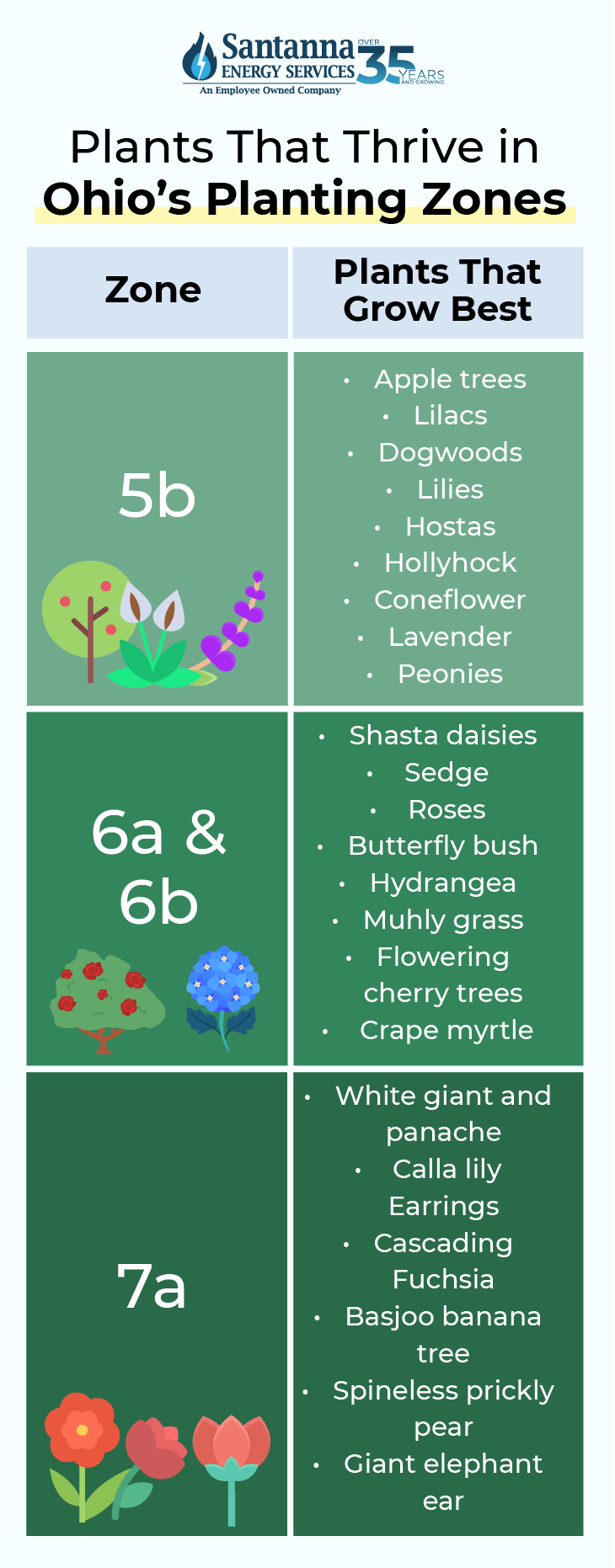
How to Use the USDA Plant Hardiness Zone Map to Identify Your Zone in Ohio
Identifying your planting zone is simple and provides essential guidance for choosing plants that will thrive in your area. Here’s how to use the USDA Plant Hardiness Zone Map to pinpoint your zone in Ohio:
- Visit the USDA Plant Hardiness Zone Map: To find your hardiness zone, go to the official USDA Plant Hardiness Zone Map online and navigate to the interactive map that allows you to explore zones across the United States, including Ohio.
- Enter Your Location: Use the search bar to enter your ZIP code or city. The map will then zoom in on your location and display your planting zone.
- Understand the Zone Information: Ohio primarily falls into Zones 6 and 7, with slight variations based on geography. Each zone is defined by the average minimum winter temperature:
- Zone 5b = -15°F to -10°F
- Zone 6a = -10°F to -5°F
- Zone 6b = -5°F to 0°F
- Zone 7a = 0°F to 5°F
- Consider Local Microclimates: Note that microclimates within your property, such as shaded areas, south-facing walls, or wind-exposed spots, can create different growing conditions than the overall zone suggests. Be sure to use this information to make adjustments for plant placement and care.
Beyond Hardiness Zones: Other Factors to Consider When Planting in Ohio
While the USDA Plant Hardiness Zones are a helpful starting point for selecting plants, other environmental and site-specific factors significantly influence gardening success. Let’s break down each of these factors to clarify their impact and how gardeners can adapt:
1. Microclimate Variations
A microclimate refers to localized conditions that differ from the broader planting zone, often due to specific features of your region or property. For example, cities located near the Great Lakes (like Cleveland) tend to experience colder temperatures or more frequent frosts. This can make planting more challenging for heat-loving plants while also extending the growing season for certain cold-climate plants.
Elevation can play a significant role in how your plants thrive, depending on your individual property and location. Low-lying areas, such as valleys or dips in the landscape, tend to trap colder air, leading to frost pockets. Meanwhile, higher elevation areas might stay warmer and experience better air circulation, reducing the risk of frost.
Consider your property’s orientation. South-facing walls or slopes that receive more sunlight and retain heat create a warmer spot ideal for heat-loving plants like tomatoes or peppers. Conversely, north-facing areas tend to stay cooler and may not support the same types of plants.
Wind exposure can affect how plants survive on your individual property. Strong winds can lower temperatures and dry out soil and plants, especially in open or exposed areas. To prevent this, plant windbreaks, like hedges or trees, to protect delicate plants and create more stable conditions.
2. Soil Conditions
The health of your soil directly impacts plant growth, as it provides essential nutrients and structure for roots:
For starters, your soil’s makeup and composition can drastically affect how your plants grow and thrive in your specific area. Some areas in Ohio have heavy clay soil, which holds water and may lead to poor drainage. Conversely, sandy soils drain too quickly and may lack nutrients.
3. Light Exposure
Different plants have varying light requirements, and understanding the light conditions in your garden can help you choose the right plants for each area. Plants like sunflowers, tomatoes, and lavender thrive in areas receiving 6+ hours of direct sunlight daily. Ferns, hydrangeas, and some leafy greens prefer a balance of sun and shade, typically 3–6 hours of sunlight daily. Hostas, coral bells, and ferns grow well in areas with minimal direct sunlight, such as under trees or on the north side of buildings.
4. Water Availability
Water is another critical factor in plant health, and matching plants to their water needs ensures optimal growth. Ohio receives moderate rainfall, but during dry periods, supplemental irrigation is essential.
Succulents, ornamental grasses, and coneflowers thrive in drier conditions and require minimal watering. Plants like Astilbes, Irises, and Willows grow best in wetter areas, such as near ponds or low-lying spots where water collects.
Common Challenges in Ohio Gardening
Gardening in Ohio comes with its unique set of challenges due to the state’s variable climate and soil conditions. However, by applying the right techniques, gardeners can overcome these obstacles and ensure their gardens thrive.
1. Frost Damage
Late spring frosts or unexpected early fall frosts can damage tender plants, flowers, and crops. This is especially a risk with counties and towns located near the lakefront, where temperatures tend to be more severe.
To prevent frost damage, be sure to monitor local weather forecasts for frost warnings and use frost covers, blankets, or garden cloches to protect plants during cold nights. Consider storing potted plants in your garage when you know frost is imminent.
Lastly, consider selecting frost-resistant or hardy plants when possible and avoid planting too early in the season.
2. Heavy Clay Soil
Many areas in Ohio have heavy clay soil, which can retain water, cause poor drainage, and compact easily, making it difficult for plants to develop healthy roots. To prevent this damage, be sure to amend the soil with organic matter, such as compost, shredded leaves, or well-rotted manure, to improve texture and drainage. Consider creating raised beds to bypass problematic soil and use deep-rooted plants or soil conditioners to break up clay naturally over time.
3. High Summer Humidity
Ohio’s hot, humid summers can lead to issues like fungal diseases (powdery mildew, leaf spot) and increased pest activity. To halt these diseases, ensure good air circulation by spacing plants appropriately and pruning excess foliage.
Be sure to water early in the morning so that leaves will dry before nightfall, which reduces the risk of fungal growth. Use mulch to retain soil moisture and keep roots cool while preventing splash-back of soil-borne diseases. Additionally, opt for disease-resistant plant varieties and monitor for pests regularly, addressing issues promptly with organic or chemical controls.
When to Plant Wildflower Seeds in Ohio
The optimal times to sow seeds for lush wildflower blooms are typically in the fall or early spring. During these periods, the weather conditions support seed germination and allow the plants to establish robust root systems before the onset of harsher conditions.
To prepare your planting area, clear any existing vegetation that might compete with the wildflowers. Lightly raking the soil will also help to break up compacted areas, ensuring that the seeds make good contact with the soil—a critical factor for successful germination.
When to Plant Grass Seed in Ohio
Plant grass seed in Ohio in early spring (mid-March to early May) or fall (mid-August to mid-October) when temperatures support germination.
If you miss the optimal sowing windows, don’t worry—there are still ways to cultivate a vibrant landscape. One option is dormant seeding, where you scatter wildflower seeds during the winter months. Additionally, consider alternative lawn care strategies such as overseeding with wildflower mixes or reducing mowing frequency to allow naturally occurring species to establish themselves.
When to Plant Vegetables in Ohio
The optimal time to plant vegetables in Ohio depends on the region’s USDA plant hardiness zones. Knowing the first and last frost dates is crucial for successful planting. For example, in Akron, the first frost date is approximately October 11th, and the last frost date is around May 4th. This gives gardeners about 170 frost-free days to grow their crops.
For the full Ohio vegetable planting schedule, visit Urban Farmer’s guide here.
When is it Too Late to Plant Grass in Ohio?
If you wait until mid-November, it’s too late to plant grass in Ohio. By late October or early November, soil temperatures often drop below the optimal range (50–65°F) for seed germination. Frost and freezing conditions can also hinder growth.
Aim to plant your grass in Ohio in early fall. Fall offers cooler temperatures and consistent moisture, providing an excellent environment for grass seed to establish.
Spring Planting Deadlines
If fall isn’t an option, spring provides moderate temperatures and ample rain, which encourages germination and root development. Late spring (mid-May onward) can be challenging due to rising temperatures, which stress young grass seedlings, and increased competition from weeds.
What to Do If You Miss the Window
If it’s late fall, consider dormant seeding by planting grass seed just before the ground freezes. The seeds will remain dormant through winter and germinate in early spring when conditions improve.
Focus on preparing the soil by removing debris, aerating, and amending it with organic matter so it’s ready for planting in the next optimal season. For immediate coverage, use sod instead of seed, as it can be installed later in the season and establishes more quickly.
Sustainable Gardening Practices
Here are some key techniques to incorporate into your gardening routine to keep the planet green:
Water Conservation
- Use rain barrels to collect rainwater, reducing the need for treated water in your garden.
- Install drip irrigation systems to supply water straight to the roots, minimizing waste and evaporation.
- Water plants early in the morning or late in the evening to reduce water loss due to heat.
Mulching
- Apply organic mulch, such as wood chips, straw, or shredded leaves, to garden beds.
- This will help retain soil moisture, reduce evaporation, and suppress weed growth while also enriching the soil as it breaks down.
Encouraging Pollinators with Native Flowers
- Plant native Ohio flowers like purple coneflowers, Black-Eyed Susans, and milkweed to attract bees, butterflies, and hummingbirds.
- Avoid using pesticides or chemicals that can harm beneficial pollinators.
- Include flowering plants with varying bloom times to ensure a steady food supply all season long.
Tips to Prepare Your Garden for Success Each Season
Here’s how Ohio gardeners can make the most of each season to ensure a thriving garden:
1. Spring: Preparing for Growth
- Clear away debris, test soil pH, and add compost or organic matter to enrich nutrients.
- Start crops like lettuce, spinach, peas, and radishes as soon as the soil is workable. Use row covers to protect young plants from frost.
- Plan your summer garden layout and start seeds indoors for warm-season vegetables.
2. Summer: Managing Growth and Maintenance
- Water deeply early in the morning to prevent evaporation and disease. Mulch garden beds to retain moisture during hot days.
- Monitor for pests such as aphids, squash bugs, and Japanese beetles. Use natural remedies like neem oil or encourage beneficial insects to control infestations.
- Start harvesting early-maturing crops and continue sowing short-season vegetables for successive harvests. =
3. Fall: Preparing for the Next Year
- Place spring-blooming bulbs, such as tulips and daffodils, in the soil before the ground freezes.
- Clean garden beds, remove spent plants and add a layer of mulch to protect perennials.
- Sow hardy vegetables like kale, carrots, and garlic for late fall harvests or overwintering.
- Winter: Planning and Indoor Gardening
- Grow herbs like basil, parsley, and chives on windowsills, or try container gardening with leafy greens.
- Review the previous year’s successes and challenges and refine your planting calendar. Then, order seeds and materials in advance for the next growing season.
- Apply compost or organic matter to fallow beds to rejuvenate soil for spring planting.
For a complete list of maintenance tips and printable checklists for year-round gardening practices, download our free eBook about sustainable yard and garden care!
Understanding planting zones is the foundation of successful gardening in Ohio. By knowing your zone, you can select plants that thrive in your area, ensuring a vibrant and resilient garden year-round. Pairing this knowledge with sustainable practices—like conserving water, using native plants, and nurturing pollinators—enhances your garden’s health while supporting the local environment.
Gardening is not just about growing plants; it’s about cultivating a connection with nature and creating a space that brings joy and beauty. Whether you’re starting your first garden or refining your techniques, take inspiration from Ohio’s diverse landscapes and unique growing opportunities.
Looking to do more with your sustainable goals than just gardening? We have Earth-Friendly Energy solutions in Ohio that help your household run smoothly and do some good for the planet too. Learn more about Earth-Friendly Electricity and Natural Gas and how you can power your home more sustainably today!
Jenna Mendez is a Midwest native with lifelong roots in Illinois and time spent in Ohio during college, giving her a deep understanding of the Midwest region’s people, climate, and energy needs. She brings firsthand experience and local insight to topics that matter to Midwest homeowners, especially energy efficiency, sustainability, and home living. Jenna specializes in writing about eco-friendly living, all things Midwest, renewable energy, and practical ways to reduce energy costs. Jenna brings a trusted, and local hometown voice to every article she writes, helping readers live well, and sustainably, right where they are.



